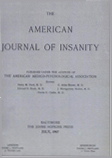THE MENTAL HEALTH PROGRAM IN TENNESSEE
Abstract
1. An account is given of the organization, general objectives and research program of a psychiatric unit established as a part of the local public health department in Williamson County, Tennessee, a rural county of approximately 25,000 population.
2. The reasons for undertaking thoroughgoing survey of psychiatric conditions in a community are discussed. The case finding procedure and the method of analyzing data obtained in a psychiatric survey of Williamson County are described. The results of a study of the status, on a specified census date (September 1, 1938), of all cases included in the survey are presented.
3. Of the 1999 cases referred as presenting conditions of psychiatric interest, 1721 were included in the population of the county on the census date; 995 were males and 726 females; 1480 were white and 241 colored. The case rate for the county was 69.4 per 1000 population.
4. For three representative areas of the county that were subjected to rather careful scrutiny the case rate was 123.7 per 1000 population. This finding indicates that the group of 1721 cases represents about 56 per cent of the total that might be found by a more intensive study of the entire county.
5. Patients in mental hospitals numbered 52, or 2.1 per 1000 population. In addition to these there were 48 persons in need of care in a mental hospital. The combined rate for persons in mental hospitals or needing hospitalization was 4.0 per 1000 population.
6. There were six persons in the State School for the Feebleminded, giving a rate of 0.2 per 1000 population. Living in the community but eligible for placement in an institution for the feebleminded were 57 persons, or 2.3 per 1000 population.
7. An analysis of the type and severity of the problems presented by the 1721 cases showed that there were problems of personal or social adjustment in 914 cases (53 per cent of the total), which were therefore classified as "active" cases. Most of the remaining cases were regarded as potentially "active." The rate for the "active" cases was 36.9 per 1000 population. When all cases of mental deficiency were included, this rate was increased to 46.7 per 1000 population.
8. The classification of the 1721 cases is given, according to the primary diagnosis or most serious condition known to have existed in each. The number of times each of the 87 diagnoses used was assigned is also indicated.
9. In 690 cases (40.1 per cent of the total) some degree of intellectual deficiency was diagnosed. One-third of the mentally defective and two-thirds of the borderline feeble-minded presented, on the census date, other personality or adjustment problems in addition to intellectual deficiency.
The authors wish to acknowledge then contributions of those who have participated in the work described in this series of communications and have helped in the preparation of material for publication. The field workers of the Williamson County Child Guidance Study staff played a major part in the accumulation of basic data and in the assembling of the data for analysis. Miss Ruth Puffer, Statistician of the State Department of Public Health, has supervised the coding of data and the preparation of tables. Dr. Persis Putnam of the staff of the International Health Division of the Rockefeller Foundation has also rendered valuable statistical assistance.
Access content
To read the fulltext, please use one of the options below to sign in or purchase access.- Personal login
- Institutional Login
- Sign in via OpenAthens
- Register for access
-
Please login/register if you wish to pair your device and check access availability.
Not a subscriber?
PsychiatryOnline subscription options offer access to the DSM-5 library, books, journals, CME, and patient resources. This all-in-one virtual library provides psychiatrists and mental health professionals with key resources for diagnosis, treatment, research, and professional development.
Need more help? PsychiatryOnline Customer Service may be reached by emailing [email protected] or by calling 800-368-5777 (in the U.S.) or 703-907-7322 (outside the U.S.).



